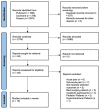Psychological Approaches for the Integrative Care of Chronic Low Back Pain: A Systematic Review and Metanalysis
- PMID: 35010319
- PMCID: PMC8751135
- DOI: 10.3390/ijerph19010060
Psychological Approaches for the Integrative Care of Chronic Low Back Pain: A Systematic Review and Metanalysis
Abstract
Chronic low back pain (CLBP) is the most common cause of disability worldwide, affecting about 12% to 30% of the adult population. Psychological factors play an important role in the experience of pain, and may be predictive of pain persistence, disability, and long-term sick leave. The aim of this meta-analysis was to identify and to describe the most common psychological approaches used to treat patients who suffer from CLBP. A systematic search was performed on PubMed/MEDLINE and Cochrane Central. Overall, 16 studies with a total of 1058 patients were included in the analysis. Our results suggest that cognitive behavioral therapy (CBT) and mindfulness-based stress reduction (MBSR) interventions are both associated with an improvement in terms of pain intensity and quality of life when singularly compared to usual care. Disability also improved in both groups when compared to usual care. Significant differences in fear-avoidance beliefs were noted in the CBT group compared to usual care. Therefore, psychological factors are related to and influence CLBP. It is crucial to develop curative approaches that take these variables into account. Our findings suggest that CBT and MBSR modify pain-related outcomes and that they could be implemented in clinical practice.
Keywords: cognitive behavioral therapy; depression; disability; fear-avoidance beliefs; low back pain; mindfulness-based stress reduction.
Conflict of interest statement
The authors declare no conflict of interest.
Figures














References
-
- Vos T., Barber R.M., Bell B., Bertozzi-Villa A., Biryukov S., Bolliger I., Charlson F., Davis A., Degenhardt L., Dicker D., et al. Global, regional, and national incidence, prevalence, and years lived with disability for 301 acute and chronic diseases and injuries in 188 countries, 1990–2013: A systematic analysis for the Global Burden of Disease Study 2013. Lancet. 2015;386:743–800. doi: 10.1016/S0140-6736(15)60692-4. - DOI - PMC - PubMed
-
- Deyo R.A., Mirza S.K., Martin B.I. Back Pain Prevalence and Visit Rates: Estimates from U.S. National Surveys, 2002. Spine. 2006;31:2724–2727. doi: 10.1097/01.brs.0000244618.06877.cd. - DOI - PubMed
Publication types
MeSH terms
LinkOut - more resources
Full Text Sources
Medical

